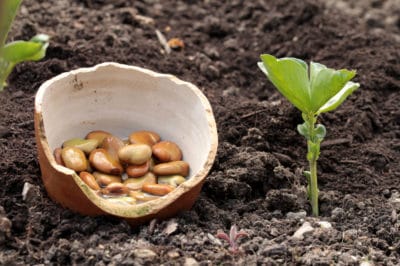Beneficial Soil Bacteria
The soil under your feet teems with millions of bacteria. Many of those bacteria species are beneficial to your plants, and Rhizobium bacteria are a good example. This type of bacteria helps legumes like beans and peas develop nodules on their roots and extract nitrogen from the soil. The stored nitrogen provides food for the plants and enriches the soil for subsequent crops.
About Inoculants
Commercial inoculants typically include Rhizobium bacteria. They may also contain mycorrhizae – fungi that promote root development. The fungi develop a mutually beneficial relationship with the plant roots by promoting their ability to take up nutrients. Mycorrhizae also improve the quality and consistency of the soil. Adding the additional bacteria and fungi gives your beans an extra boost and promotes plant health.
Why Use Inoculants?
Although beneficial bacteria are naturally present in the soil, the additional benefits of inoculants will be quickly apparent. The sooner the plant is able to start fixing nitrogen, the faster it can put on growth. Beans planted with inoculants will typically be larger and have a deeper green color (indicating more chlorophyll production). Inoculants can also mean earlier flower production and harvest.
How to Apply Inoculants
There is no one way to apply or use inoculants. You can:
- Sprinkle the inoculant on the soil and work it in.
- Sprinkle inoculant on a smooth surface; soak the bean seeds and then roll them in inoculant just before planting.
- Dig a furrow, soak the soil well with water and then sprinkle inoculant in the bottom. Plants seeds and cover with soil.
Feeding the Soil
Legumes like beans prefer a slightly acidic soil, and so does the Rhizobium bacteria. Keep the pH around 6.5 for best results. Soil bacteria feed on humus, so it’s important to supply your soil with plenty of well-rotted leaf mold, organic compost and/or aged manure. Commercial fertilizers may help the plants grow, but they don’t do much for the soil bacteria. Too much nitrogen only promotes excessive leaf growth.
Making Your Own
Many gardeners have experimented with making their own inoculants. Soil that has previously grown legumes is usually colonized with the right bacteria. Add it to your beds or make a tea by soaking it in water and then watering the beans. Another method is to soak rice in milk, which promotes growth of lactobacillus species. Chopped mushrooms and mushroom litter can be soaked in water to obtain mycorrhizae.
